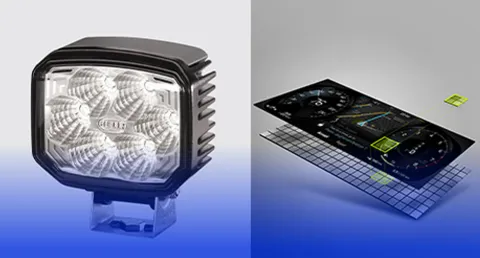Waves of Innovation: Eco-design as the Base

FORVIA integrates sustainability into engineering from concept to production. Environmental impact is assessed throughout design and development, guiding, for example, material selection, component architecture and manufacturing methods.
Building on the success of the FORVIA Excellence System (FES), FES for Engineering brings the same mindset to our engineering development processes—now with design for sustainability as one of its pillars. This framework ensures every product development follows a clear approach integrating eco-design from the earliest stages of development. This process supports FORVIA’s ambition to reduce Scope 3 CO₂ emissions by 90% by 2045.
Design for sustainability in 6 Steps
Six guiding principles transform sustainability goals into actionable engineering practices, guiding design throughout the entire product life cycle. They apply to both innovation and program development, ensuring sustainability thinking is embedded from the start.
#1 – Compliance with regulations and vigilance on responsible sourcing
Compliance and responsible sourcing are the starting point of every product development process. Each material is carefully verified against evolving regulations on harmful substances. The same care extends to responsible sourcing which also considers sustainability issues like the use of scarce materials, non-ethical extraction or feedstocks competing with food or natural resources.
FORVIA has already implemented processes to limit the usage of harmful chemicals and requires that its suppliers fulfill reporting obligation on this class of substances. Also, FORVIA requires that its suppliers comply with a code of conduct and disclose information about their mineral supply chains and origins.
Our MATERI’ACT materials take a proactive approach to sustainability principles. For example, the NAFILean family incorporates diverse biomass sources—such as hemp, wood, reed, olive pits and oyster shells. These sources are carefully selected to avoid any risk of food competition or deforestation.
# 2 - Usage of Sustainable Materials with low CO₂ footprint
Selecting the right material is central to sustainable design. In the current FORVIA scope, sustainable materials are biobased materials, recycled materials and green steel.
The IniCycled family leverages post-industrial and post-consumer plastics to create durable components. Ecorium—a sustainable alternative to leather made from recycled PET and hemp—offers significantly lower emissions compared to traditional leather. These innovations demonstrate how material design can directly cut Scope 3 emissions.
#3 - Product design facilitating the implementation of sustainable manufacturing processes
Engineering and manufacturing move forward together under FES for Engineering. Designs are evaluated for their impact on energy, water and waste before reaching production.
A redesign of the exhaust entry cone replaced casting with stamping, significantly reducing energy requirements in the production process.
# 4 - Product design minimizing the vehicle energetic consumption during usage
Reducing emissions continues once the product leaves the factory. Lightweighting, energy-efficient electronics and smart component design all help to lower CO₂ emissions during vehicle use.
Replacing metal with plastic in the IVI Silver Box reduced component weight by 30% . The Microjet process achieved up to 25% weight savings using bio-inspired structures. In displays, Smart Dimming and GreenHDR cut energy use by as much as 30%. Even lighting systems, such as the Power Beam family from lifecycle solutions, integrate these gains, using corrosion-resistant plastics instead of aluminum to reduce weight and CO₂ impact.
#5 - Durability and repairability in line with customer expectations
Designing for longevity helps close material loops. The Sustainable Repair Solution for Trailer Multifunction Tail Lights from Lifecycle Solutions enables mechanical and electronic repairs instead of full unit replacement, extending lifespan and reducing waste. Other modular systems, such as seats and lighting modules, are designed for disassembly, repair or upgrade, keeping components in circulation longer and reinforcing a circular economy approach.
#6 - Product recyclability at the vehicle End-of-Life
The product life cycle continues well beyond its use phase. Under new End-of-Life Vehicle (ELV) regulations, recyclability is a design criterion from the start. FORVIA’s work on hydrogen tank recyclability increased recoverable material from 25% to 70% through optimized dismantling and thermoplastic resin innovation, with a target of 85% in future designs. Each improvement strengthens the company’s position in a circular automotive industry.
Non-Negotiable Eco-Design
Eco-design is a baseline requirement for every program, integrated into the Group Innovation Process from concept to launch.
Through FES for Engineering, this standard becomes operational. Eco-design principles guide product design. This approach creates accountability and make environmental performance as essential as safety, quality and cost.
FES for Engineering builds a product design culture where sustainability and innovation advance together. It also embodies the Blue Effect - the idea that every action, regardless of scale, contributes to a larger positive impact on our environment and society. Each design decision, each improvement in process or material, adds to this collective effect, shaping the sustainable mobility of tomorrow.




